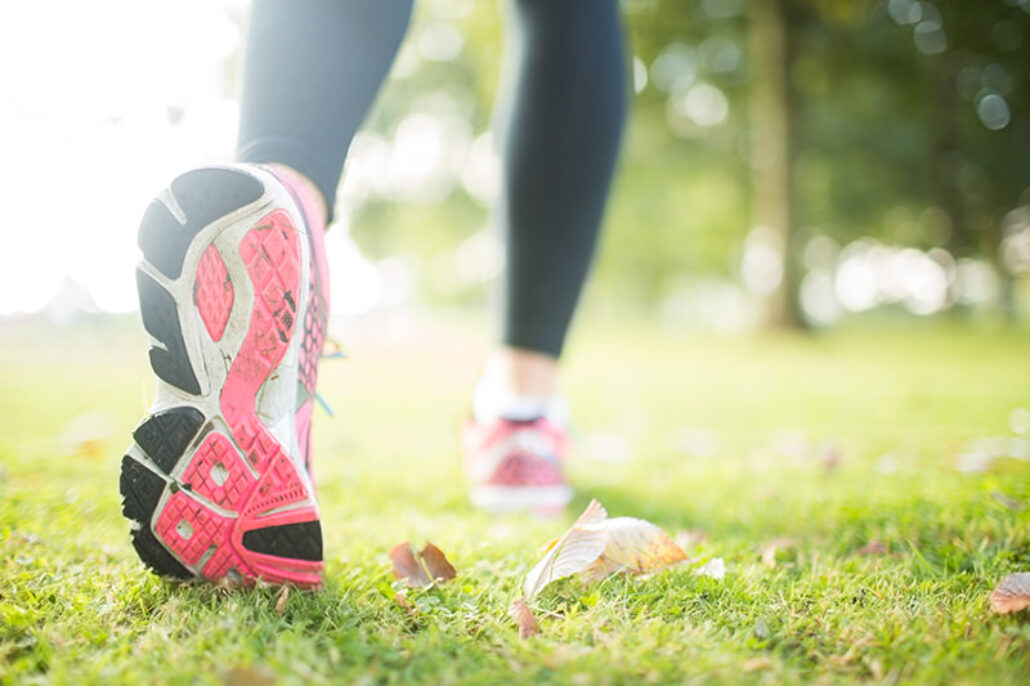Choosing the right running shoe starts with an understanding of the relationship between our feet and our bodies. Summit physical therapist Sam Olson explains how our feet inform our body, and discusses the latest research about running shoes.
As a physical therapist at Summit Orthopedics, Sam Olson has treated his share of runners. He has helped them recover from injuries, and talks with them about how to evaluate running shoes for individual fit and injury prevention.
“Let’s start with the basics,” says Sam. “Shoes protect our feet from the ground. The goal of a shoe should be to keep the foot closer to an anatomically neutral position as we walk and run, but anatomy differs in each person. Shoe companies offer a variety of features to accomplish this. You can find shoes that offer special cushioning, differences in thickness between the heel and forefoot (which is called the “drop”), various forefoot widths, different shoe weights, and foot motion control features. There are also minimalist shoes that are designed to protect feet while trying to maintain the form your foot would have if you were barefoot, forcing your body to do the work of controlling the foot motion.”
“Before we talk about choosing a shoe, it is important to understand how wearing shoes is different from going barefoot,” Sam continues. “Our feet are like our hands in that they are sensory organs with a large number of nerve endings that give important feedback to our brain about our interaction with the environment. This feedback influences the force of our steps, the number of muscles we use as we move, and prompts subtle adjustments in our body’s center of pressure. Some biomechanics and footwear experts suggest that wearing shoes may decrease this important sensory feedback, and make our running form less ideal.”
Over the last few years, medical research has been exploring a possible connection between the biomechanics of running form and footwear. A recent review of scientific literature compared runners who ran in shoes to runners who run barefoot and runners who run in minimalist shoes. The review found no difference in injury prevention between the three types of running. However, they did find that barefoot runners experienced the following beneficial biomechanical advantages compared to runners who ran in traditional running shoes:
- Barefoot runners experienced less vertical ground reaction force; the impact of each stride is divided more evenly across all tissues. High vertical ground reaction forces are linked to certain running injuries.
- Barefoot runners had less knee joint extension and impact force at the knee, which is vulnerable to injury when it has to withstand and absorb larger amounts of force at each stride.
- When barefoot runners land each step, they experience less force with each heel strike.
- Barefoot runners benefit from advantages in their form; they have less ground contact time, shorter strides, increased frequency of strides, and increased knee flexion when their feet make contact with the ground.
“The research is interesting, and ongoing,” says Sam. “There’s no best way to “prescribe” a shoe, but it’s important to note that proper running form is the most important factor in reducing injury. The links between minimal shoes and better running form led the American College of Sports Medicine to update their footwear recommendation. Now they are advocating less of a shoe, though individual comfort is still the best indicator that you’ve got the right fit for your feet.”
Summit Orthopedics offers personalized foot and ankle expertise
Our fellowship-trained foot and ankle physicians understand that your mobility depends on the health of your feet and ankles. If you have suffered an injury or are experiencing symptoms that make walking painful, our team of foot and ankle specialists can help with conservative treatment, seasoned surgical teams, and expert rehabilitation support. Summit Orthopedics specialists have the expertise to evaluate your discomfort and develop a plan to quickly and safely get you back on your feet and on your way.
Start your journey to optimal foot health. Find your foot and ankle expert, request an appointment online, or call us at (651) 968–5201 to schedule a consultation.
Summit has convenient locations across the Minneapolis-St. Paul metro area, serving Minnesota and western Wisconsin. We have state-of-the-art centers for comprehensive orthopedic care in Eagan, MN, Plymouth, MN, Vadnais Heights, MN, and Woodbury, MN, as well as additional community clinics throughout the metro and southern Minnesota.
More resources for you
- Are Your Shoes Dangerous To Your Foot Health?
- Ask Sam Olson: Should Running Shoes Be Based On Arch Shape?
- Ask Sam Olson: How Do I Find The Right Running Shoe?
Additional resources for you
- Ask Dr. Scofield: Guidelines For Transitioning To A New Running Shoe
- Ask Dr. Scofield: What Can Runners Do To Reduce The Risks Of Achilles Tendonopathy?

